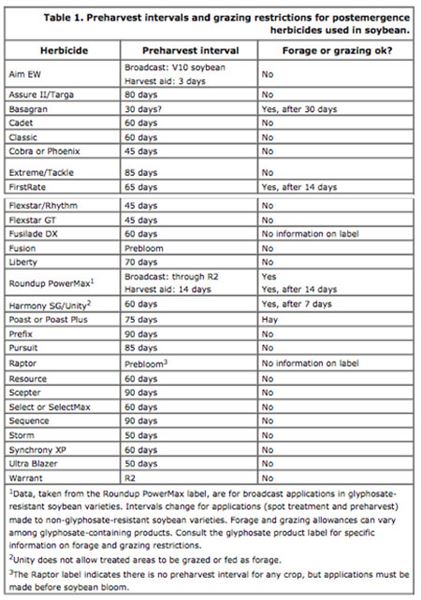PrecautionsWith Late-Season Herbicide Applications
URBANA, ILL.
Performance of many foliar-applied soybean
herbicides has been challenged by the adverse
environmental conditions common
across much of Illinois. Weeds that survive an
initial herbicide application are often resprayed,
with the same herbicide or a different one. The
likelihood of controlling larger, moisturestressed
weeds at this point in the growing season
continues to decline, for myriad reasons.
Apart from that, be reminded that late-season
herbicide applications increase the probability
that herbicide residues will persist long enough
to injure sensitive rotational crops.
Nearly all herbicide labels (soil-applied and
postemergence) specify the time that must
elapse between herbicide application and planting
of a rotational crop. The rotational crop intervals
become particularly important with
late-season herbicide applications and when soil
moisture is limited. The intervals are established
to reduce the likelihood that herbicide residues
will persist in sufficient quantities to adversely
affect the rotational crop. Some restrictions are
based solely on time, while other factors, such
as soil pH and the amount of precipitation received
after herbicide application, can influence
the length of the intervals.
Soil moisture is often the most critical factor
governing the efficacy and persistence of soilresidual
herbicides. Many herbicides are degraded
in soil by the activity of soil microorganisms,
and populations of these microorganisms
can be greatly depressed when soil moisture is
limited. Also, dry soils can enhance herbicide
adsorption to soil colloids, rendering the herbicide
unavailable for plant uptake and degradation
by soil microbial populations. Some
herbicide rotational intervals are increased if a
specified amount of precipitation is not received
by a certain date.

Please keep in mind that the labels of almost
all postemergence soybean herbicides indicate a
preharvest interval or a soybean developmental
stage beyond which applications cannot be
made. Labels of some products may indicate
both a developmental stage (before soybean
bloom, for example) and a preharvest interval.
Preharvest intervals indicate the time that must
elapse between the herbicide application and
crop harvest. Failure to observe the preharvest
interval may result in herbicide residue levels in
the harvested portion of the crop exceeding established
limits. Also, livestock grazing or foraging
treated soybean is prohibited by the labels
of many postemergence soybean herbicides.
Table 1 details preharvest intervals and grazing
restrictions for a number of postemergence soybean
herbicides. Δ
DR. AARON HAGER: Extension Specialist,
Weed Science/IPM, University of Illinois